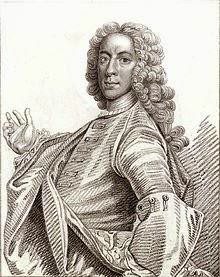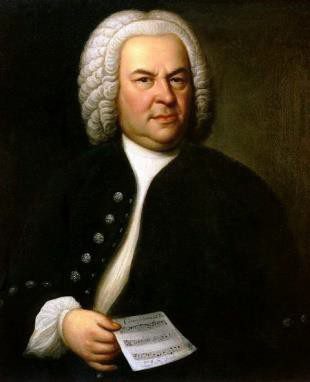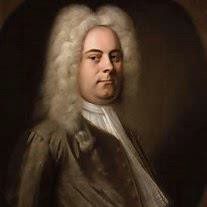Vincent P. de Luise

(1703-1772)
George Frideric Handel and Johann Sebastian Bach, the towering musical giants of the Baroque, were both coincidently born in Germany about a month apart, in 1685. They also shared the musical style distinctive of the high Baroque characterized by the masterful use of counterpoint and fugal composition. Handel’s oratorios, notably Messiah and Samson, are operatic in nature, much like his beloved opera serie (serious operas) Giulio Cesare, Rodelinda, Ariodante, and Alcina. Bach’s Passion According to St. John shares this operatic style along with his many surviving cantatas, viewed by some as miniature operatic works.
But something else also unites these two Baroque masters, namely a medical bond. They both suffered visual loss at the end of their lives, and even more coincidentally both composers may have undergone eye surgery by the same person, the mountebank who went by the name the Chevalier John Taylor.
The following excerpt from the autobiography of the Chevalier John Taylor catalyzed this essay on Bach and Handel and their failing eyesight:
“I have, at Leipsick (Leipzig), seen a celebrated master of music, who had already arrived to his 88th year, and who received his sight by my hands; it is with this very man that the famous Handel was first educated, and with whom I once thought to have had the same success, having all circumstances in his favour, motions of the pupil, and light, but upon drawing the curtain, we found the bottom defective, from a paralytic disorder.”1
The “celebrated master of music” was of course Johann Sebastian Bach, likely sixty-five and not “in his 88th” year when Taylor met him. Handel was not educated by Bach, nor was it likely the two ever met, although Bach tried several times, was very fond of Handel’s music, and copied some of it out. Taylor did treat Bach, but it is not as clear whether he operated on Handel, although the last clause in the excerpt above implies that Taylor may have treated Handel as well.

from Bartish 1538
The Chevalier John Taylor was born in 1703, son of a surgeon of the same name. He studied at St. Thomas’ Hospital under Professor William Cheselden, specialized in eye diseases, and soon thereafter proclaimed himself the “Ophthalmiater Royal” (a neologism that he coined, to mean “Royal Eye Physician”). He then proclaimed himself “Oculist (Ophthalmologist) to King George II and the Pope.” His motto was “In Optics, Expertissimus!”
Despite his rigorous medical training, Taylor was an itinerant surgeon and for the most part, a charlatan. He coined the Latin expression “Qui visum visam dat” or “He who gives sight, gives life.” He then revised this motto into the grammatically incorrect “qui dat videre dat vivere” and emblazoned it on the canvas side of his horse-drawn wagon, which was adorned with painted eyes. From this vehicle he would bring out the nostrums and elixirs of his charlatan trade, feigning to cure the visually impaired. One of Taylor’s common ruses was to make a minute conjunctival incision in the afflicted eye and patch the other eye, receive his fee, instruct the patient to leave the eye covered for a week. By the time the patient removed the eye covering and noticed no improvement, he was miles away.
Taylor’s ego was larger than life, his self-promotion unrivaled. He fancied himself not only an oculist but also a medical writer. A prominent ophthalmic treatise of the time, printed by Robert Fleming in Edinburgh in 1759, was authored by the said Chevalier John Taylor, with the Brobdingnagian title: An Exact Account of Two Hundred and Forty-three different Diseases, to which the Eye and its Coverings are exposed, All Copied after Nature in the Order many Years given, in various Languages, Latin, French, Italian, Spanish, Portoguese, etc etc. in the Several Courts and in the Presence of Crowned Heads, Sovereign Princes, and in many of the Most Celebrated Academies, Universities and Societies of the Learned, the author, the Chevalier John Taylor, Ophthalmatier, Pontificial, Imperial and Royal, viz., etc etc…. Qui Visum Vitam Dat.2
At least Taylor used the correct Latin in the book’s title.

(1685-1750)
Taylor would travel from village to town, ostensibly to treat the blind. If he diagnosed that the patient had a cataract, he would ““couch” (vide infra) the cataract from the individual so afflicted.”** He would also give the patient purgatives and at times bloodlet him as well. Then he would slip out of town before the inevitable consequences of eye surgery at the time came to pass – intraocular hemorrhage or infectious endophthalmitis. Taylor later confessed that after he started practicing his trade, in Switzerland, he had “blinded hundreds of patients.”1 Cataract surgery in the eighteenth century was not the global success story it is today, and technology was primitive. Oculists would wait for cataracts to become mature, or “ripe.” Then, without anesthesia and using a long, sharp hook or lance, they would push, or “couch,” the cataract into the vitreous cavity, ideally (though by no means always) out of the pupillary axis, thus allowing light to re-enter. However, this was now unfocused light that reached the retina. Thus, the patient still needed glasses (those strong, thick, “coke bottle” glasses) to restore some form of clear vision. It appears that the Chevalier Taylor was a master of couching crystalline lenses, whether or not they were cataractous.
Johann Sebastian Bach was born in Leipzig in 1685. He became a renowned composer of church and organ music, cantatas and concertos, composing over 1,100 works. Apparently, Bach’s only infirmity was his vision. He was said to have had “naturally bad vision… weakened by a lot of study.”3 However, if he were myopic, which was likely, this condition was not very severe, as he was able to sit for a long time at the organ over the course of years and read music without glasses. Because of his failing eyesight, likely due to cataracts, Bach was introduced to the Chevalier John Taylor, who in 1750 operated on him twice. Bach may have improved somewhat after the first operation, but, as is evident from the newspaper articles of the day, after the second operation (it is not clear if one or both eyes were operated upon) his vision suffered and he became ill with what was described as a hitziges Fieber (a non-specific term which translates as “burning fever”). He lingered on for a few months and died on July 28, 1750, at 6:15 PM, at age sixty-six.

(1685-1759)
It has been surmised that Bach developed either an eye infection from the surgery or an increase in intraocular (eye) pressure and a subsequent stroke. But the eye surgery may not have been the proximate cause of his death, for he lived about four months after it.3 Had infectious endophthalmitis spread to cause a fatal septic meningitis this would in the absence of intravitreal antibiotics have occurred within a week and not have taken four months.
George Frideric Handel (Ger. Georg Friedrich Händel) was born in Halle, Germany, in 1685. After a successful Grand Tour of Italy between 1705 and 1709, where he became acquainted with the Italian operatic style and was feted by Prince Ruspoli as “il Caro Sassone” (‘the dear Saxon”), he returned to Hanover to work for George, the Elector of Hanover. He quickly decamped to London in 1710, two years before George, who himself went over in 1712 to become King George I after the death of Queen Anne. In 1751, at age of sixty-six and after four decades of extraordinary successes in opera and oratorio, Handel began noticing changes in his eyesight. Some scholars insist that he had cataracts, because he had his putative cataracts “couched” by the Chevalier Taylor. However, the evidence for this comes from one source alone: Taylor’s own writings. Apart from this there is no independent documentation that Handel was seen or cared for by Taylor, or what the composer’s visual impairment may have been. According to the Chevalier Taylor, he performed couching procedures on Handel several times. If true, then Handel’s medical history replicated J.S. Bach’s. Fortunately for Handel, despite unsuccessful surgery to both eyes, he lived a few more years after the operations. But a close reading of Handel’s personal correspondence discloses that the visual loss that he sustained was not monocular, but binocular, and more importantly, the visual loss in each eye was abrupt and sudden. As cataracts do not cause sudden visual loss it is more likely (despite the bombastic pronouncements and rodomontade by the Chevalier Taylor) that Handel had sustained consecutive strokes to the ophthalmic artery of each eye from an entity called anterior ischemic optic neuropathy (AION).

Messiah by Louis Francois Roubilia (Westminister Abbey unveiled in 1762)
The relevant excerpt from the Chevalier Taylor’s diaries about Handel’s purported eye exam gives a clue: “…but upon drawing the curtain, we found the bottom defective, from a paralytic disorder.” “Upon drawing the curtain” is a metaphor implying “upon removing the cataract” (if it existed). If that is the case, then Taylor evidently did find that the “bottom” usually referred to the “fundus”, or the back of the eye, where the retina and optic nerve are located) was defective, “from a paralytic disorder.” This could have meant the consequences of sudden blood loss, ischemia, or “stroke.” In the eighteenth century, the concept of ischemia to a target tissue or organ was not clearly understood even though a century earlier William Harvey had already made great discoveries in this regard in his monumental 1628 treatise, Du Motu Cordis (On the Motion of the Heart). AION may cause optic nerve ischemia and death, and may be associated with other systemic illnesses such as rheumatoid arthritis or polymyalgia rheumatica. Handel’s age of sixty-six at that time is consistent with case studies of AION, whereas he would have been somewhat too young to have significant visual loss from cataracts. Reviewing the epidemiology of AION, one finds the disease more common in persons with Scandinavian or German heritage. Handel, born in Germany, fits this demographic risk factor as well. On August 5, 1752, The General Advertiser of London reported: “We hear that George-Frederick Handel, Esq., the celebrated Composer of Musick, was seized a few Days ago with a Paralytick Disorder of the Head, which has deprived him of Sight.”
After his visual loss, Handel’s health inexorably declined through the last eight years of his life. He became more religious, more introspective, and retreated into a cocoon of solitude and silence. Although he still played the organ and acceded to conduct the occasional Messiah, his compositional style changed. He went on to complete the oratorio Jephtha in 1752, his last work in the genre. Handel’s days as a composer of opera seria were long past as well; his last opera, Deidamia, premiered in 1741, victim of a sea-change in the taste of London society. It remained for Mozart to resurrect the genre briefly with Idomeneo (1781) and La Clemenza di Tito (1791). Handel died on April 14, 1759 at the age of seventy-two, a justly famous and widely admired cultural icon. He was buried in Westminster Abbey. Having never married and having no children, he left his estate to his niece, Johanna, and also, as per four separate codicils, to his friends, his servants, and several charities. Ironically, the Chevalier John Taylor himself went gradually blind and notwithstanding Charles Burney’s claim that “I dined with the Chevalier at my table d’hote a few days before he passed away,” he apparently died alone, in 1772.4 Posterity has been a most grateful beneficiary of the works of both J.S. Bach and “Mr. Händel.”
Their rich musical creations remain a trove of artistic beauty, extraordinary in both quality and quantity. Despite their visual impairments, Bach and Handel retained wondrous acoustic capacities, through which they conjured and crafted such a sublime and indelible musical legacy.
Ars longa, vita brevis Sic transit Gloria mundi.
References
- Jackson, D.M., Bach, Handel and the Chevalier John Taylor. Medical History 1968; 12: 385- 393.
- Library of the Surgeon General of the United States, Historical Society Exhibit, March, 1915.
- Zegers, R. The Eyes of Johann Sebastian Bach. Arch Ophthalmol 2005; 123: 1427-1430.
- Burney, C. Music, Men and Manners in France and Italy. Reprint. London, The Folio Society. 1969.
is an assistant clinical professor of ophthalmology at Yale University School of Medicine, and adjunct clinical assistant professor of ophthalmology at Weill Cornell Medical College, where he also serves on the Music and Medicine Initiative Advisory Board. A clarinetist, he was the director of the Connecticut Mozart Festival in the bicentenary year of the composer’s death, is president of the Connecticut Summer Opera Foundation, and writes frequently about music and the arts.
© 2015 Vincent P. de Luise MD FACS, published in part on the internet website, Only Opera, www.onlyopera.com, 2014.

Leave a Reply